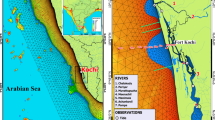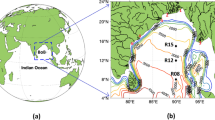Abstract
A three-level nested Regional Ocean Modeling System was used to examine the seasonal evolution of the Copper River (CR) plume and how it influences the along- and across-shore transport in the northern Gulf of Alaska (NGoA). A passive tracer was introduced in the model to delineate the growth and decay of the plume and to diagnose the spread of the CR discharge in the shelf, into Prince William Sound (PWS) and offshore. Furthermore, a model experiment with doubled discharge was conducted to investigate potential impacts of accelerated glacier melt in future climate scenarios. The 2010 and 2011 simulation revealed that the upstream (eastward) transport in the NGoA is negligible. About 60 % of the passive tracer released in the CR discharge is transported southwestward on the shelf, while another one third goes into PWS with close to 60 % of which exiting PWS to the shelf from Montague Strait. The rest few percent is transported across the shelf break and exported to the GoA basin. The downstream transport and the transport into PWS are strongly regulated by the downwelling-favorable wind, while the offshore transport is related to the accumulation of plume water in the shelf, frontal instability, and the Alaskan Stream. It takes weeks in spring for the buoyancy to accumulate so that a bulge forms outside of the CR estuary. The absence of strong storms as in the summer of 2010 allows the bulge continue growing to trigger frontal instability. These frontal features can interact with the Alaskan Stream to induce transport pulses across the shelf break. Alternatively as in 2011, a downwelling-favorable wind event in early August (near the peak discharge) accelerates the southwestward coastal current and produces an intense downstream transport event. Both processes result in fast drains of the buoyancy and the plume content, thereby rapid disintegration of the plume in the shelf. The plume in the doubled discharge case can be two to three times in size, which affects not only the magnitude but also the timing of certain transport events. In particular, the offshore transport increases by several folds because the plume appears to be more easily entrained by the seaward flow along the side of Hinchinbrook Canyon.














Similar content being viewed by others
References
Anders AM, Sletten RS, Derry LA, Hallet B (2003) Germanium/silicon ratios in the Copper River Basin, Alaska: Weathering and partitioning in periglacial versus glacial environments. J Geophys Res 108:6005
Arendt AA, Echelmeyer KA, Harrison WD, Lingle CS, Valentine VB (2002) Rapid wastage of Alaska glaciers and their contribution to rising sea level. Science 297:382–386
Avicola G, Huq P (2003a) The characteristics of the recirculating bulge region in coastal buoyant outflows. J Mar Res 61:435–463
Avicola G, Huq P (2003b) The role of outflow geometry in the formation of the recirculating bulge region in coastal buoyant outflows. J Mar Res 61:411–434
Boyd PW, Law CS, Wong CS, Nojiri Y, Tsuda A, Levasseur M, Takeda S, Rivkin R, Harrison PJ, Strzepek R (2004) The decline and fate of an iron-induced subarctic phytoplankton bloom. Nature 428:549–553
Chai F, Dugdale RC, Peng T, Wilkerson FP, Barber RT (2002) One-dimensional ecosystem model of the equatorial Pacific upwelling system. Part I: model development and silicon and nitrogen cycle. Deep-Sea Res II Top Stud Oceanogr 49:2713–2745
Chase Z, Strutton PG, Hales B (2007) Iron links river runoff and shelf width to phytoplankton biomass along the US West Coast. Geophys Res Lett 34:L4607
Childers AR, Whitledge TE, Stockwell DA (2005) Seasonal and interannual variability in the distribution of nutrients and chlorophyll a across the Gulf of Alaska shelf: 1998–2000. Deep-Sea Res II Top Stud Oceanogr 52:193–216
Colas F, Wang X, Capet X, Chao Y, McWilliams JC (2012) Untangling the roles of wind, run-off and tides in Prince William Sound. Cont Shelf Res 63:S79–S89
Crawford WR (2005) Heat and fresh water transport by eddies into the Gulf of Alaska. Deep-Sea Res II Top Stud Oceanogr 52:893–908
Crawford WR, Brickley PJ, Thomas AC (2007) Mesoscale eddies dominate surface phytoplankton in northern Gulf of Alaska. Prog Oceanogr 75:287–303
Denamiel C, Budgell WP, Toumi R (2013) The Congo River plume: impact of the forcing on the far–field and near–field dynamics. J Geophys Res Oceans 139:334–339
Dugdale RC, Barber RT, Chai F, Peng T, Wilkerson FP (2002) One-dimensional ecosystem model of the equatorial Pacific upwelling system. Part II: sensitivity analysis and comparison with JGOFS EqPac data. Deep-Sea Res II Top Stud Oceanogr 49:2747–2768
Farrara JD, Chao Y, Li Z, Wang X, Jin X, Zhang H, Li P, Vu Q, Olsson PQ, Carl Schoch G (2012) A data-assimilative ocean forecasting system for the Prince William Sound and an evaluation of its performance during Sound Predictions 2009. Cont Shelf Res 63:S193–S208
Fong DA, Geyer WR (2002) The alongshore transport of freshwater in a surface-trapped river plume. J Phys Oceanogr 32:957–972
Garvine RW (1999) Penetration of buoyant coastal discharge onto the continental shelf: a numerical model experiment. J Phys Oceanogr 29:1892–1909
Geyer WR, Signell RP, Fong DA, Wang J, Anderson DM, Keafer BA (2004) The freshwater transport and dynamics of the western Maine coastal current. Cont Shelf Res 24:1339–1357
Hallet B, Hunter L, Bogen J (1996) Rates of erosion and sediment evacuation by glaciers: a review of field data and their implications. Glob Planet Chang 12:213–235
Henson SA, Thomas AC (2008) A census of oceanic anticyclonic eddies in the Gulf of Alaska. Deep-Sea Res I Oceanogr Res Pap 55:163–176
Hermann AJ, Haidvogel DB, Dobbins EL, Stabeno PJ (2002) Coupling global and regional circulation models in the coastal Gulf of Alaska. Prog Oceanogr 53:335–367
Hickey BM, Pietrafesa LJ, Jay DA, Boicourt WC (1998) The Columbia River plume study: subtidal variability in the velocity and salinity fields. J Geophys Res Oceans 103:10339–10368, 1978–2012
Hickey BM, Geier S, Kachel N, MacFadyen A (2005) A bi-directional river plume: the Columbia in summer. Cont Shelf Res 25:1631–1656
Hinckley S, Coyle KO, Gibson G, Hermann AJ, Dobbins EL (2009) A biophysical NPZ model with iron for the Gulf of Alaska: reproducing the differences between an oceanic HNLC ecosystem and a classical northern temperate shelf ecosystem. Deep-Sea Res II Top Stud Oceanogr 56:2520–2536
Hood E, Scott D (2008) Riverine organic matter and nutrients in southeast Alaska affected by glacial coverage. Nat Geosci 1:583–587
Kourafalou VH, Oey L, Wang JD, Lee TN (1996) The fate of river discharge on the continental shelf 1. Modeling the river plume and the inner shelf coastal current. J Geophys Res 101:3415–3434
Ladd C, Stabeno P, Cokelet ED (2005a) A note on cross-shelf exchange in the northern Gulf of Alaska. Deep-Sea Res II Top Stud Oceanogr 52:667–679
Ladd C, Kachel NB, Mordy CW, Stabeno PJ (2005b) Observations from a Yakutat eddy in the northern Gulf of Alaska. J Geophys Res 110:C3003
Large WG, McWilliams JC, Doney SC (1994) Oceanic vertical mixing: a review and a model with a nonlocal boundary layer parameterization. Rev Geophys 32:363–403
Li Z, Chao Y, Farrara JD, McWilliams JC (2013) Impacts of distinct observations during the 2009 Prince William Sound field experiment: a data assimilation study. Cont Shelf Res 63:S209–S222
Lippiatt SM, Lohan MC, Bruland KW (2010) The distribution of reactive iron in northern Gulf of Alaska coastal waters. Mar Chem 121:187–199
Luthcke SB, Arendt AA, Rowlands DD, McCarthy JJ, Larsen CF (2008) Recent glacier mass changes in the Gulf of Alaska region from GRACE mascon solutions. J Glaciol 54:767–777
Menzel A, Sparks TH, Estrella N, Koch E, Aasa A, Ahas R, ALM KÜBLER K, Bissolli P, Braslavská O, Briede A (2006) European phenological response to climate change matches the warming pattern. Glob Chang Biol 12:1969–1976
Milliman JD, Meade RH (1983) World-wide delivery of river sediment to the oceans. J Geol 91:1–21
Milly PC, Dunne KA, Vecchia AV (2005) Global pattern of trends in streamflow and water availability in a changing climate. Nature 438:347–350
Okkonen SR, Weingartner TJ, Danielson SL, Musgrave DL, Schmidt GM (2003) Satellite and hydrographic observations of eddy-induced shelf-slope exchange in the northwestern Gulf of Alaska. J Geophys Res 108:3033
Powell RD, Molnia BF (1989) Glacimarine sedimentary processes, facies and morphology of the south-southeast Alaska shelf and fjords. Mar Geol 85:359–390
Royer TC (1975) Seasonal variations of waters in the northern Gulf of Alaska. Paper presented at Deep Sea Research and Oceanographic Abstracts. Elsevier
Royer TC (1982) Coastal fresh water discharge in the northeast Pacific. J Geophys Res Oceans 87:2017–2021, 1978–2012
Royer TC (2005) Hydrographic responses at a coastal site in the northern Gulf of Alaska to seasonal and interannual forcing. Deep-Sea Res II Top Stud Oceanogr 52:267–288
Schiller RV, Kourafalou VH, Hogan P, Walker ND (2011) The dynamics of the Mississippi River plume: impact of topography, wind and offshore forcing on the fate of plume waters. J Geophys Res Oceans (1978–2012) 116. doi:10.1029/2010JC006883
Schofield O, Chao Y (2013) Accomplishments and future perspective of coastal ocean observing systems. Cont Shelf Res 63:S79–S89
Schroth AW, Crusius J, Sholkovitz ER, Bostick BC (2009) Iron solubility driven by speciation in dust sources to the ocean. Nat Geosci 2:337–340
Stabeno PJ, Hermann AJ, Bond NA, Bograd SJ (1995a) Modeling the impact of climate variability on the advection of larval walleye pollock (Theragra chalcogramma) in the Gulf of Alaska. Can Spec Pub Fish Aquat Sci 121:719–727
Stabeno PJ, Reed RK, Schumacher JD (1995b) The Alaska coastal current: continuity of transport and forcing. J Geophys Res 100:2477–2485
Stabeno PJ, Bond NA, Hermann AJ, Kachel NB, Mordy CW, Overland JE (2004) Meteorology and oceanography of the Northern Gulf of Alaska. Cont Shelf Res 24:859–897
Taylor KE (2001) Summarizing multiple aspects of model performance in a single diagram. J Geophys Res Atmos 106:7183–7192, 1984–2012
Thomas AC, Weatherbee RA (2006) Satellite-measured temporal variability of the Columbia River plume. Remote Sens Environ 100:167–178
Wang X, Chao Y, Zhang H, Farrara J, Li Z, Jin X, Park K, Colas F, McWilliams JC, Paternostro C (2012) Modeling tides and their influence on the circulation in Prince William Sound, Alaska. Cont Shelf Res 63:S126–S137
Weingartner TJ, Danielson SL, Royer TC (2005) Freshwater variability and predictability in the Alaska coastal current. Deep-Sea Res II Top Stud Oceanogr 52:169–191
Wendler G, ShulSki M (2009) A century of climate change for Fairbanks, Alaska. Arctic 62(3):295–300
Whitney MM, Garvine RW (2005) Wind influence on a coastal buoyant outflow. J Geophys Res 110:C3014
Xiu P, Chai F, Xue H, Shi L, Chao Y (2012) Modeling the mesoscale eddy field in the Gulf of Alaska. Deep-Sea Res I Oceanogr Res Pap 63:102–117
Xue H, Du Y (2010) Implementation of a wetting-and-drying model in simulating the Kennebec–Androscoggin plume and the circulation in Casco Bay. Ocean Dyn 60:341–357
Yankovsky AE, Chapman DC (1997) A simple theory for the fate of buoyant coastal discharges. J Phys Oceanogr 27:1386–1401
Acknowledgments
The authors would like to thank Lei Shi for the initial implementation of the coupled ROMS-CoSiNE model for the Gulf of Alaska, as well as Stephen Cousins and Peng Xiu for their helps with model runs. The computation was carried out using the facility of the University of Maine Advanced Computing Group. Thanks also go to other project collaborators, John Crusius, Rob Campbell, and Andrew Schroth for providing the observational data used in this study; and to Tom Weingartner, Seth Danielson and David Leech for maintaining and sharing GAK1 data. This work was supported by the U.S. Geological Survey (USGS) grant #G10AC00048.
Author information
Authors and Affiliations
Corresponding author
Additional information
Responsible Editor: Richard John Greatbatch
This article is part of the Topical Collection on the 5th International Workshop on Modelling the Ocean (IWMO) in Bergen, Norway 17-20 June 2013
Rights and permissions
About this article
Cite this article
Wang, Y., Xue, H., Chai, F. et al. A model study of the Copper River plume and its effects on the northern Gulf of Alaska. Ocean Dynamics 64, 241–258 (2014). https://doi.org/10.1007/s10236-013-0684-3
Received:
Accepted:
Published:
Issue Date:
DOI: https://doi.org/10.1007/s10236-013-0684-3




